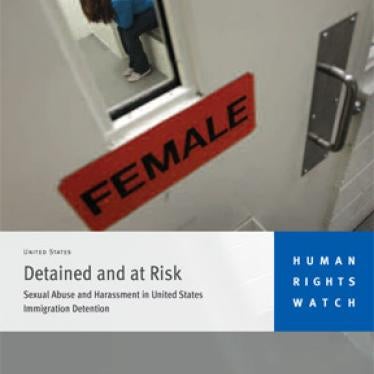(Washington, DC) - The indictment of a prison guard in a sexual abuse case of a detained immigrant underscores the need for the US government to provide immigration detainees the same protections from rape that it plans for other prisoners, Human Rights Watch said today.
The one-count federal felony indictment was issued on June 23, 2011. It charges that Edwin Rodriguez, 31, a contract security officer at the Willacy Detention Center in Raymondville, Texas, sexually abused a detainee held by Immigration and Customs Enforcement (ICE) in October 2008. If convicted, Rodriguez could face up to 15 years in prison and a $250,000 fine.
"Prosecuting this case is important, but providing immigration detainees the same rape protections as other prisoners could prevent these horrific crimes in the first place," said Meghan Rhoad, women's rights researcher at Human Rights Watch. "The US government needs to protect the hundreds of thousands of women and men held in immigration detention each year from sexual abuse."
Under the Prison Rape Elimination Act of 2003 (PREA), the Justice Department has proposed a regulation to prevent and respond to rape in prisons and jails nationwide. However, the Notice of Proposed Rulemaking issued by the Justice Department on January 24 says that the proposed regulation would "not encompass facilities that are primarily used for the civil detention of aliens pending removal from the United States."
The National Prison Rape Elimination Commission had recommended, however, that the standards include special protection for immigration detainees to respond to their unique needs and vulnerabilities and the current lack of accountability for those who abuse them. The commission, an expert body, was created under the PREA statute to study the problem of prison rape and propose national standards to the Justice Department.
In February, Human Rights Watch and 10 other organizations, in a letter to President Barack Obama, expressed grave concern about the exclusion of immigration detainees from these protections against sexual assault. The organizations said the exclusion ignores the history of sexual assault in immigration detention and is inconsistent with the intent of Congress in passing PREA and the administration's own efforts at detention reform. The decision also has implications for basic human rights obligations undertaken by the United States, the groups said. The administration did not respond to the letter, and the Justice Department has yet to finalize the regulation.
A Human Rights Watch report in August 2010 compiled over 50 documented incidents and allegations of sexual assault, abuse, and harassment in immigration detention since the formation of ICE in 2003. These may represent a small proportion of the actual cases, since immigrants in detention are often afraid to report an incident or are deported before they are able to make a report, Human Rights Watch said.
Shortly before publication of the report, ICE indicated its intention to improve its procedures for preventing and responding to sexual assault. However, the changes are part of a package of revised policies governing conditions of detention that have been stalled for months, reportedly held up by negotiations between the ICE leadership and its officers' union.
The Willacy Detention Center in Raymondville, Texas, where the Rodriguez indictment alleges the assault occurred, gained infamy as the "tent city" where structures made out of Kevlar were constructed to create the largest facility nationwide for immigrants detained pending deportation proceedings. In the summer of 2009, Dora Schriro, then an adviser on detention to the homeland security secretary, investigated allegations of sexual abuse at Willacy. The results have not been made public.
However, ICE has said it plans to stop using Willacy soon because it is well below capacity. ICE began shifting female detainees out of Willacy and into the all-female Hutto detention center in Taylor, Texas, as part of detention reforms announced in October 2010.
Immigration detention is the fastest-growing incarceration system in the US. In 2009, ICE had custody of between 380,000 and 442,000 people in about 300 US detention facilities. Some were held in service processing centers operated directly by ICE and others in contract detention facilities managed by private companies, state and county jails under contract with ICE, or facilities run by the Federal Bureau of Prisons. Juvenile immigrant detainees are held in facilities operated by the US Department of Health and Human Services. While the average immigration detainee is detained 30 days, detention can last years for some.
"The situation in immigration detention has passed the point where improved sexual assault prevention measures can be indefinitely postponed by bureaucratic hurdles," Rhoad said. "At this stage, the Obama administration should forcefully intervene to protect the safety of the men and women in ICE custody."







